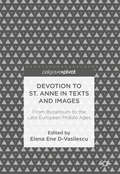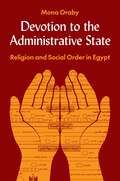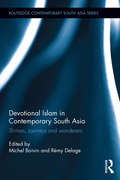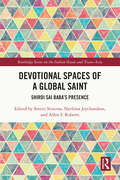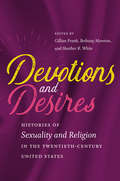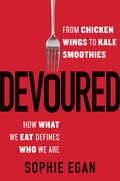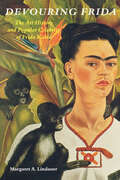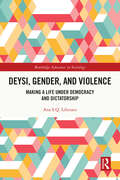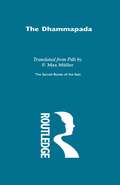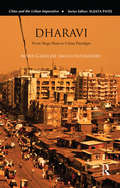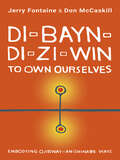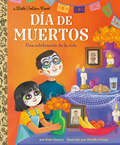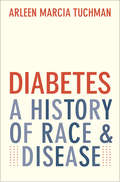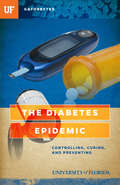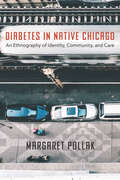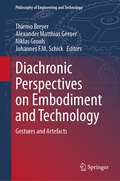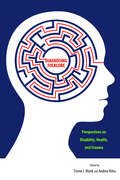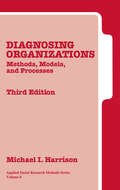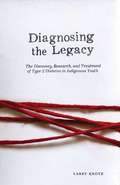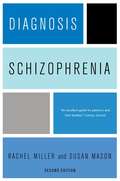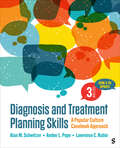- Table View
- List View
Devotion to St. Anne in Texts and Images: From Byzantium to the Late European Middle Ages
by Elena Ene D-VasilescuSt. Anne was popular with representatives of various segments of society – from monks, nuns, members of the clergy, royal patrons, to church-goers of every rank. This book looks into both the public and private worship of this holy woman and brings to the surface some under-exposed aspects of it. It does so through the examination of manuscripts, monumental art, relics, sculpture, and texts of various genres. The contributors employ a historical as well as a theological perspective on how the cult of St. Anne (sometimes also with glimpses concerning that of Joachim) established itself, referring to areas in Europe which are not frequently discussed in English-language scholarship. This new contribution to the field of hagiography will be of interest to academics from a variety of research fields, including theologians, Byzantinists, art and church historians, and historians of a larger scope.
Devotion to the Administrative State: Religion and Social Order in Egypt
by Mona OrabyWhy the pursuit of state recognition by seemingly marginal religious groups in Egypt and elsewhere is a devotional practiceOver the past decade alone, religious communities around the world have demanded state recognition, exemption, accommodation, or protection. They make these appeals both in states with a declared religious identity and in states officially neutral toward religion. In this book, Mona Oraby argues that the pursuit of official recognition by religious minorities amounts to a devotional practice. Countering the prevailing views on secularism, Oraby contends that demands by seemingly marginal groups to have their religious differences recognized by the state in fact assure communal integrity and coherence over time. Making her case, she analyzes more than fifty years of administrative judicial trends, theological discourse, and minority claims-making practices, focusing on the activities of Coptic Orthodox Christians and Baháʼí in modern and contemporary Egypt.Oraby documents the ways that devotion is expressed across a range of sites and sources, including in lawyers&’ offices, administrative judicial verdicts, televised media and film, and invitation-only study sessions. She shows how Egypt&’s religious minorities navigated the political and legal upheavals of the 2011 uprising and now persevere amid authoritarian repression. In a Muslim-majority state, they assert their status as Islam&’s others, finding belonging by affirming their difference; and difference, Oraby argues, is the necessary foundation for collective life. Considering these activities in light of the global history of civil administration and adjudication, Oraby shows that the lengths to which these marginalized groups go to secure their status can help us to reimagine the relationship between law and religion.
Devotional Islam in Contemporary South Asia: Shrines, Journeys and Wanderers (Routledge Contemporary South Asia Series)
by Michel Boivin Remy DelageThe Muslim shrine is at the crossroad of many processes involving society and culture. It is the place where a saint – often a Sufi - is buried, and it works as a main social factor, with the power of integrating or rejecting people and groups, and as a mirror reflecting the intricacies of a society. The book discusses the role of popular Islam in structuring individual and collective identities in contemporary South Asia. It identifies similarities and differences between the worship of saints and the pattern of religious attendance to tombs and mausoleums in South Asian Sufism and Shi`ism. Inspired by new advances in the field of ritual and pilgrimage studies, the book demonstrates that religious gatherings are spaces of negotiation and redefinitions of religious identity and of the notion of sainthood. Drawing from a large corpus of vernacular and colonial sources, as well as the register of popular literature and ethnographic observation, the authors describe how religious identities are co-constructed through the management of rituals, and are constantly renegotiated through discourses and religious practices. By enabling students, researchers and academics to critically understand the complexity of religious places within the world of popular and devotional Islam, this geographical re-mapping of Muslim religious gatherings in contemporary South Asia contributes to a new understanding of South Asian and Islamic Studies.
Devotional Spaces of a Global Saint: Shirdi Sai Baba's Presence (Routledge Series on the Indian Ocean and Trans-Asia)
by Smriti Srinivas Neelima Jeychandran Allen F. RobertsDevotional Spaces of a Global Saint focuses on the presence and contemporaneity of Shirdi Sai Baba (d.1918), who has a vast following in postcolonial South Asia and an ever-growing global diaspora. Essays consider the saint’s influence on everyday life and how visual, narrative, textual, sensorial, performative, political, social, and spatial practices interpenetrate to produce multiple terrains of devotion. Contributions by twelve scholars of several academic disciplines explore eruptions and circulations of sacred materials, spatialities of devotional practices, visual and digital imaginaries, transcultural narrativizations, and material affects and effects of Sai Baba. The presentation transcends routine scholarly discussions about sainthood, cultures of worship, religious objects, Hinduism and Islam. Shirdi Sai Baba’s presence conveys inspiration and healing energies and he accepted the entreaties of people of all castes and creeds, offering an alternative to communal ideologies of his time – and the present. Considerations of Shirdi Sai Baba’s milieux of devotional praxis situate and localize debates about the meaning of nation and religion, past and present, urbanization, and class identity in transitions from colonial to postcolonial/global South Asia. The book expands the boundaries of the study of Shirdi Sai Baba and makes important contributions to South Asia Studies, Anthropology, Religious Studies, Global Studies, Urban Studies, Indian Ocean Studies, Inter-Asian Studies, Visual and Media Studies, and Cultural Geography.
Devotions and Desires: Histories of Sexuality and Religion in the Twentieth-Century United States
by Gillian Frank Bethany Moreton Heather R. WhiteAt a moment when "freedom of religion" rhetoric fuels public debate, it is easy to assume that sex and religion have faced each other in pitched battle throughout modern U.S. history. Yet, by tracking the nation's changing religious and sexual landscapes over the twentieth century, this book challenges that zero-sum account of sexuality locked in a struggle with religion. It shows that religion played a central role in the history of sexuality in the United States, shaping sexual politics, communities, and identities. At the same time, sexuality has left lipstick traces on American religious history. From polyamory to pornography, from birth control to the AIDS epidemic, this book follows religious faiths and practices across a range of sacred spaces: rabbinical seminaries, African American missions, Catholic schools, pagan communes, the YWCA, and much more. What emerges is the shared story of religion and sexuality and how both became wedded to American culture and politics. The volume, framed by a provocative introduction by Gillian Frank, Bethany Moreton, and Heather R. White and a compelling afterword by John D'Emilio, features essays by Rebecca T. Alpert and Jacob J. Staub, Rebecca L. Davis, Lynne Gerber, Andrea R. Jain, Kathi Kern, Rachel Kranson, James P. McCartin, Samira K. Mehta, Daniel Rivers, Whitney Strub, Aiko Takeuchi-Demirci, Judith Weisenfeld, and Neil J. Young.
Devoured: From Chicken Wings to Kale Smoothies—How What We Eat Defines Who We Are
by Sophie EganA provocative look at how and what Americans eat and why—a flavorful blend of The Omnivore’s Dilemma, Salt Sugar Fat, and Freakonomics that reveals how the way we live shapes the way we eat.Food writer and Culinary Institute of America program director Sophie Egan takes readers on an eye-opening journey through the American food psyche, examining the connections between the values that define our national character—work, freedom, and progress—and our eating habits, the good and the bad. Egan explores why these values make for such an unstable, and often unhealthy, food culture and, paradoxically, why they also make America’s cuisine so great.Egan raises a host of intriguing questions: Why does McDonald’s have 107 items on its menu? Why are breakfast sandwiches, protein bars, and gluten-free anything so popular? Will bland, soulless meal replacements like Soylent revolutionize our definition of a meal? The search for answers takes her across the culinary landscape, from the prioritization of convenience over health to the unintended consequences of “perks” like free meals for employees; from the American obsession with “having it our way” to the surge of Starbucks, Chipotle, and other chains individualizing the eating experience; from high culture—artisan and organic and what exactly “natural” means—to low culture—the sale of 100 million Taco Bell Doritos Locos Tacos in ten weeks. She also looks at how America’s cuisine—like the nation itself—has been shaped by diverse influences from across the globe.Devoured weaves together insights from the fields of psychology, anthropology, food science, and behavioral economics as well as myriad examples from daily life to create a powerful and unique look at food in America.
Devouring Frida: The Art History and Popular Celebrity of Frida Kahlo
by Margaret A. LindauerBeginning in the late 1970's Frida Kahlo achieved cult heroine status less for her richly surrealist self-portraits than by the popularization of the events of her tumultuous life. Her images were splashed across billboards magazine ads, and postcards; fashion designers copied the so-called "Frida" look in hairstyles and dress; and "Fridamania" even extended to T-shirts, jewelry, and nail polish. Margaret A. Lindauer argues that this mass market assimilation of Kahlo's identity has consistently detracted from appreciation of her work, leading instead to narrow interpretations based on "an entrenched narrative of suffering." While she agrees that Kahlo's political and feminist activism, her stormy marriage to fellow artist Diego Reviera, and the tragic reality of a progressively debilitated body did represent a biography colored by emotional and physical upheaval, she questions an "author-equals-the-work" critical tradition that assumes a :one-to-one association of life events to the meaning of a painting." In kahlo's case, Lindauer says, such assumptions created a devouring mythology, an iconization that separates us from rather than leads us to the real significance of the oeuvre. Accompanied by 26 illustrations and deep analysis of Kahlo's central themes, this provocative, semiotic study recontextualizes an important figure in art history at the same time it addresses key questions about the language of interpretation, the nature of veneration, and the truths within self-representation.
Deysi, Gender, and Violence: Making a Life Under Democracy and Dictatorship (Routledge Advances in Sociology)
by Ana S.Q. LiberatoThis book shares the life narrative of Deysi Quiñones to shed light on the intricate relationship between her life and the wider cultural, political, social, and historical contexts of the Dominican Republic. Deysi’s life narrative is a microhistory that sheds light on the intersection of gender, violence, and poverty under the Trujillo regime and in its wake. Her story recovers pieces of rural life, which has been disrupted, transformed, and made less visible by the neoliberal order. It emphasizes the significance of expanding the Trujillo regime archive to encompass a broader spectrum of perspectives and attract more scholarly attention to Petán Trujillo’s legacies. Deysi’s life story can provide meaningful lessons and insights for today in the realm of gendered violence and children’s exploitation.This book is intended as reading for sociology, gender and women’s studies, history, Latin American politics, and Caribbean and Latin American Studies courses and for a general educated audience. The book intersects with topics that are widely covered in research in the humanities and social sciences and is appropriate for both advanced undergraduate and graduate courses. The book can appeal to human rights activists, novelists, and individuals and organizations interested in history, politics, authoritarian societies, and gendered violence.
The Dhammapada and Sutta-Nipata
by F. Max MullerThis is a subset of F. Max Mullers great collection The Sacred Books of the East which includes translations of all the most important works of the seven non-Christian religions which have exercised a profound influence on the civilizations of the continent of Asia. The works have been translated by leading authorities in their field.
Dharavi: From Mega-Slum to Urban Paradigm (Cities And The Urban Imperative Ser.)
by Marie-Caroline Saglio-YatzimirskyLocated in the heart of Mumbai, Dharavi is estimated to be the largest slum in Asia. Often referred to as ‘Little India’, it has been home to thousands of migrants from across the country providing opportunities for work and livelihood. As such, Dharavi presents a fascinating paradox: the convergence of stereotypes associated with the slum — poverty and misery — and an effervescent economic vitality, impelled by globalisation and international capital flows.Bringing together 20 years of painstaking fieldwork, this book reveals the social, economic, political, and urban complexities that define Dharavi beneath the shadow of Mumbai, the financial capital of India. It provides a rare account of the slum’s history, with a special focus on the original populace of leather workers — who form the backbone of its urban informal economy — their work, organisation and increasing political awareness. Dominated by a population of ex-‘untouchables’, conventionally stigmatised by poverty and low status, Dharavi illustrates how traditional caste-based occupational and regional divisions continue to be strong and affect structures of political governance and economy. At the same time, it testifies to an intimate encounter with consumerism, liberalisation and technological innovations, and its resultant cultural globalisation under the heady influence of media, advertising and cinema transmitted by the city of Mumbai.This book traces the mega-slum’s gradual transformation as a thriving trade centre, through an informal economy’s successful adaptation to global markets, in turn establishing an urban paradigm. It will be useful to those in sociology, anthropology, urban studies, politics, public policy and governance, and to those interested in globalisation, transnational migration and town planning.
Dhow Chasing in Zanzibar Waters: And on the Eastern Coast of Africa. Narrative of Five Years' Experience in
by Captain G.L. SullivanA useful guide to the state of the slave trade in 1850 and how the trade increased from then until 1873 when up to three times the amount of slaves were being traded. First published in 1873.
Di-bayn-di-zi-win (To Own Ourselves): Embodying Ojibway-Anishinabe Ways
by Jerry Fontaine Don McCaskillA collaboration exploring the importance of the Ojibway-Anishinabe worldview, use of ceremony, and language in living a good life, attaining true reconciliation, and resisting the notions of indigenization and colonialization inherent in Western institutions.Indigenization within the academy and the idea of truth and reconciliation within Canada have been seen as the remedy to correct the relationship between Indigenous Peoples and Canadian society. While honourable, these actions are difficult to achieve given the Western nature of institutions in Canada and the collective memory of its citizens, and the burden of proof has always been the responsibility of Anishinabeg.Authors Makwa Ogimaa (Jerry Fontaine) and Ka-pi-ta-aht (Don McCaskill) tell their di-bah-ji-mo-wi-nan (Stories of personal experience) to provide insight into the cultural, political, social, and academic events of the past fifty years of Ojibway-Anishinabe resistance in Canada. They suggest that Ojibway-Anishinabe i-zhi-chi-gay-win zhigo kayn-dah-so-win (Ways of doing and knowing) can provide an alternative way of living and thriving in the world. This distinctive worldview — as well as Ojibway-Anishinabe values, language, and ceremonial practices — can provide an alternative to Western political and academic institutions and peel away the layers of colonialism, violence, and injustice, speaking truth and leading to true reconciliation.
Día de Muertos: Una celebración de la vida (Little Golden Book)
by Polo OrozcoRinde honor y recuerda a tus seres queridos este Día de Muertos con este Little Golden Book hermosamente ilustrado acerca de la festividad.Honor and remember loved ones on the Day of the Dead with this beautifully illustrated Little Golden Book about the holiday.El Día de Muertos es una celebración alegre. La tradición mexicana es un momento para darle la bienvenida a esos seres queridos que ya no se encuentran con nosotros. Esto se hace con ofrendas que incluyen comidas favoritas, flores de cempasúchil brillantes y coloridas, calaveras de azúcar y mucho más. Este Little Golden Book, ideal para leerse en voz alta, es perfecto para las familias que celebran el Día de Muertos y para aquellos que desean aprender más acerca de la festividad.Day of the Dead is a happy celebration. The Mexican holiday is a time to welcome back loved ones who are no longer with us. This is done with offerings of favorite foods, brightly colored marigolds, sugar skulls, and more. This Little Golden Book is a great read-aloud for families that celebrate Day of the Dead, as well as for those who want to learn more about it.
Diabetes: A History of Race and Disease
by Arleen Marcia TuchmanWho gets diabetes and why? An in‑depth examination of diabetes in the context of race, public health, class, and heredity Who is considered most at risk for diabetes, and why? In this thorough, engaging book, historian Arleen Tuchman examines and critiques how these questions have been answered by both the public and medical communities for over a century in the United States. Beginning in the late nineteenth century, Tuchman describes how at different times Jews, middle‑class whites, American Indians, African Americans, and Hispanic Americans have been labeled most at risk for developing diabetes, and that such claims have reflected and perpetuated troubling assumptions about race, ethnicity, and class. She describes how diabetes underwent a mid-century transformation in the public&’s eye from being a disease of wealth and &“civilization&” to one of poverty and &“primitive&” populations. In tracing this cultural history, Tuchman argues that shifting understandings of diabetes reveal just as much about scientific and medical beliefs as they do about the cultural, racial, and economic milieus of their time.
Diabetes and Aging-related Complications
by Sho-Ichi YamagishiThis book addresses why and how the aging process is accelerated under diabetes, providing valuable and comprehensive information for the management of various types of diabetes- and aging-related disorders. Since several papers have shown that average life span and healthy life expectancy are reduced in diabetic patients, especially in those with a long history of disease, the early detection and treatment of diabetes-related complications are urgently needed in order to slow the aging process and help people successfully live with diabetes. Each chapter of this book addresses a specific diabetes and aging-related complication. The topics covered include not only diabetic vascular complications, the leading causes of morbidities and high mortality rates in both type 1 and type 2 diabetic patients, but also other aging-related complications such as Alzheimer's disease, osteoporosis, periodontitis and cancer growth and metastasis. Experts on each topic disc uss the background of the aging process and methods for coping with diabetes-related complications. The book as a whole, as well as the individual chapters, offer a valuable resource for researchers and practitioners in the fields of diabetic studies, gerontology, and aging science.
The Diabetes Epidemic: Controlling, Curing, and Prevention
by Leonora LaPeter Anton University of FloridaThe University of Florida has an ambitious goal: to harness the power of its faculty, staff, students, and alumni to solve some of society’s most pressing problems and to become a resource for the state of Florida, the nation, and the world. The Diabetes Epidemic explores the complicated landscape of diabetes research and offers a glimpse of the extraordinarily difficult, and sometimes serendipitous, ways in which breakthroughs occur. At the University of Florida Diabetes Institute more than 100 faculty members are working on education, research, prevention, and treatment. Their fields are diverse—genetics, endocrinology, epidemiology, patient and physician education, health outcomes and policy, behavioral science, and rural medicine—but their goal is the same. Jump into the trenches with the doctors, scientists, and research nurses at the Diabetes Institute to learn about the challenges associated with developing treatments. Meet a brother who is helping his sister by participating in one of the largest studies ever undertaken of people at risk for Type 1 diabetes. Visit the largest open-access repository of diabetic pancreases in the world, where the most studied is that of a 12-year-old boy who had Type 1 diabetes for only a year. Spend time with one of the foremost diabetes researchers as he decides which pancreases to study, deploys experimental projects to answer new questions, and struggles to fund additional investigations. Discover why Type 2 diabetes is affecting more and more people and how some of them control it, and learn about a few of the most promising Type 2 treatments currently under study. While a cure has not yet been found, the researchers at UF’s Diabetes Institute are working to improve the lives of the estimated 415 million people currently suffering from the disease worldwide. The stories chronicled in GATORBYTES span all colleges and units across the UF campus. They detail the far-reaching impact of UF’s research, technologies, and innovations—and the UF faculty members dedicated to them. Gatorbytes describe how UF is continuing to build on its strengths and extend the reach of its efforts so that it can help even more people in even more places.
Diabetes in Native Chicago: An Ethnography of Identity, Community, and Care
by Margaret PollakIn Diabetes in Native Chicago Margaret Pollak explores experiences, understandings, and care of diabetes in a Native American community made up of individuals representing more than one hundred tribes from across the United States and Canada. Today Indigenous Americans have some of the highest rates of diabetes worldwide. While rates of diabetes climbed in reservation areas, they also grew in cities, where the majority of Native people live today. Pollak&’s central argument is that the relationship between human culture and human biology is a reciprocal one: colonial history has greatly contributed to the diabetes epidemic in Native populations, and the diabetes epidemic is being incorporated into contemporary discussions of ethnic identity in Native Chicago, where a vulnerability to the development of diabetes is described as a distinctly Native trait. This work is based upon ethnographic research in Native Chicago conducted between 2007 and 2017, with ethnographic and oral history interviews, observations, surveys, and archival research. Diabetes in Native Chicago illustrates how local understandings of diabetes are shaped by what community members observe in cases of the disease among family and friends. Pollak shows that in the face of this epidemic, care for disease is woven into the everyday lives of community members. Diabetes is not merely a physical disease but a social one, perpetuated by social policies and practices, and can only be thwarted by changing society.
Diachronic Perspectives on Embodiment and Technology: Gestures and Artefacts (Philosophy of Engineering and Technology #46)
by Thiemo Breyer Alexander Matthias Gerner Niklas Grouls Johannes F. M. SchickThis book investigates the relationships between gestures and artefacts theoretically and historically, by analyzing different phenomena stemming from a variety of fields such as robotics, archaeology, gesture studies, anthropology, philosophy, and gestural practices like choreography, music performance, and composition. It underlines how embodiment and technology change the interplay between maker and artefact over time and appeals to students and researchers in these fields. Its goal is to enable the reader to understand that the recurring topics and questions as well as multi-level similarities are by no means accidental, but can best be understood if one pays attention to the intertwinements of materiality and cognition, praxis and techne.
Diagnosing Folklore: Perspectives on Disability, Health, and Trauma
by Trevor J. Blank Andrea KittaDiagnosing Folklore provides an inclusive forum for an expansive conversation on the sensitive, raw, and powerful processes that shape and imbue meaning in the lives of individuals and communities beleaguered by medical stigmatization, conflicting public perceptions, and contextual constraints. This volume aims to showcase current ideas and debates, as well as promote the larger study of disability, health, and trauma within folkloristics, helping bridge the gaps between the folklore discipline and disability studies. This book consists of three sections, each dedicated to key issues in disability, health, and trauma. It explores the confluence of disability, ethnography, and the stigmatized vernacular through communicative competence, esoteric and exoteric groups in the Special Olympics, and the role of family in stigmatized communities. Then, it considers knowledge, belief, and treatment in regional and ethnic communities with case studies from the Latino/a community in Los Angeles, Javanese Indonesia, and Middle America. Lastly, the volume looks to the performance of mental illness, stigma, and trauma through contemporary legends about mental illness, vlogs on bipolar disorder, medical fetishism, and veterans' stories.
Diagnosing Organizations: Methods, Models, and Processes (Applied Social Research Methods #8)
by Michael I. HarrisonClick ′Additional Materials′ for downloadable sample chapterMany managers and organizational leaders face shrinking budgets, growing competition, and changing organizational alliances and missions A bewildering array of new technologies and management techniques offer help in handling these challenges. To respond effectively and avoid wasting resources, decision makers need to diagnose organizational conditions, plan changes carefully, and apply appropriate technologies and management techniques. The Third Edition of the bestselling Diagnosing Organizations shows how consultants and applied researchers can help decision makers quickly and flexibly diagnose problems and challenges and decide how to deal with them. Key FeaturesModels for framing diagnostic problems, identifying underlying conditions, and providing feedback Methods for gathering and analyzing diagnostic data Processes for working on a diagnosis with clients and other members of an organizationThis thoroughly revised edition can help practitioners of diagnosis directly address concerns that are critical to clients, rather than just provide feedback on current conditions and operations. In an authoritative, yet readable fashion author Michael I. Harrison presents updated treatments of the uses of diagnosis, evaluating organizational effectiveness, improving team performance, planning organization redesign projects, and assessing organization-environment relations and competitive strategy. Also treated are the politics of change management, professional dilemmas, and ethical issues confronting practitioners. Professors of research methods across the social sciences will find Diagnosing Organizations, Third Edition an invaluable text for their courses. The second edition was widely adopted in departments of Management, Public Health, Nursing, Education, Public Administration, Psychology, Criminal Justice, and many others.
Diagnosing Organizations: Methods, Models, and Processes (Applied Social Research Methods #8)
by Michael I. HarrisonClick ′Additional Materials′ for downloadable sample chapterMany managers and organizational leaders face shrinking budgets, growing competition, and changing organizational alliances and missions A bewildering array of new technologies and management techniques offer help in handling these challenges. To respond effectively and avoid wasting resources, decision makers need to diagnose organizational conditions, plan changes carefully, and apply appropriate technologies and management techniques. The Third Edition of the bestselling Diagnosing Organizations shows how consultants and applied researchers can help decision makers quickly and flexibly diagnose problems and challenges and decide how to deal with them. Key FeaturesModels for framing diagnostic problems, identifying underlying conditions, and providing feedback Methods for gathering and analyzing diagnostic data Processes for working on a diagnosis with clients and other members of an organizationThis thoroughly revised edition can help practitioners of diagnosis directly address concerns that are critical to clients, rather than just provide feedback on current conditions and operations. In an authoritative, yet readable fashion author Michael I. Harrison presents updated treatments of the uses of diagnosis, evaluating organizational effectiveness, improving team performance, planning organization redesign projects, and assessing organization-environment relations and competitive strategy. Also treated are the politics of change management, professional dilemmas, and ethical issues confronting practitioners. Professors of research methods across the social sciences will find Diagnosing Organizations, Third Edition an invaluable text for their courses. The second edition was widely adopted in departments of Management, Public Health, Nursing, Education, Public Administration, Psychology, Criminal Justice, and many others.
Diagnosing the Legacy: The Discovery, Research, and Treatment of Type 2 Diabetes in Indigenous Youth
by Larry Krotz Frances Desjarlais Heather Dean Jonathan McGavock Michael Moffatt Elizabeth SellersIn the late 1980s, pediatric endocrinologists at the Children’s Hospital in Winnipeg began to notice a new cohort appearing in their clinics for young people with diabetes. Indigenous youngsters from two First Nations in northern Manitoba and northwestern Ontario were showing up not with type 1 (or insulin-dependent diabetes), but with what looked like type 2 diabetes, until then a condition that was restricted to people much older. Investigation led the doctors to learn that something similar had become a medical issue among young people of the Pima Indian Nation in Arizona though, to their knowledge, nobody else. But these youth were just the tip of the iceberg. Over the next few decades more children would confront what was turning into not only a medical but also a social and community challenge. "Diagnosing the Legacy" is the story of communities, researchers, and doctors who faced—and continue to face—something never seen before: type 2 diabetes in younger and younger people. Through dozens of interviews, Krotz shows the impact of the disease on the lives of individuals and families as well as the challenges caregivers faced diagnosing and then responding to the complex and perplexing disease, especially in communities far removed from the medical personnel a facilities available in the city.
Diagnosis: A Comprehensive Resource for Consumers, Families, and Helping Professionals, Second Edition
by Rachel MillerIn this book, thirty-five young, recently diagnosed patients speak about schizophrenia and the process of recovery, while two specialists illuminate the medical science, psychoeducation, and therapeutic needs of those coping with the illness, as well as access to medical benefits and community resources. A remarkably inclusive guide, the volume informs patients, families, friends, and professionals, detailing the possible causes of schizophrenia, medications and side effects, the functioning of the brain, and the value of rehabilitation and other services. In their dialogues, participants confront shame, stigma, substance use, and relapse issues and the necessity of healthy eating, safe sex practices, and coping skills during recovery. Clinicians elaborate on the symptoms of schizophrenia, such as violent and suicidal thoughts, delusions, hallucinations, memory and concentration problems, trouble getting motivated or organized, and anxiety and mood disorders. Adopting an uplifting tone of manageability, the participants, authors, and clinicians of this volume offer more than advice-they prescribe hope.
Diagnosis and Treatment Planning Skills: A Popular Culture Casebook Approach
by Alan M. Schwitzer Amber L. Pope Lawrence C. RubinThe Third Edition of Alan M. Schwitzer, Amber L. Pope, and Lawrence C. Rubin′s Diagnosis and Treatment Planning Skills: A Popular Culture Casebook Approach thoroughly covers essential clinical thinking skills in professional counseling through classic and contemporary popular culture case examples. Fully revised for use with the DSM-5-TR, the text begins with discussion of diagnosis, case conceptualization, and current treatment planning practices, covering the interplay of individual clinical tools and their application in contemporary practice. Twenty DSM-5-TR updated case illustrations follow, representing a diverse range of individual differences and intersecting identities. Students will engage with each case illustration in a start-to-finish application of clinical tools.
Diagnosis and Treatment Planning Skills: A Popular Culture Casebook Approach
by Alan M. Schwitzer Amber L. Pope Lawrence C. RubinThe Third Edition of Alan M. Schwitzer, Amber L. Pope, and Lawrence C. Rubin′s Diagnosis and Treatment Planning Skills: A Popular Culture Casebook Approach thoroughly covers essential clinical thinking skills in professional counseling through classic and contemporary popular culture case examples. Fully revised for use with the DSM-5-TR, the text begins with discussion of diagnosis, case conceptualization, and current treatment planning practices, covering the interplay of individual clinical tools and their application in contemporary practice. Twenty DSM-5-TR updated case illustrations follow, representing a diverse range of individual differences and intersecting identities. Students will engage with each case illustration in a start-to-finish application of clinical tools.
